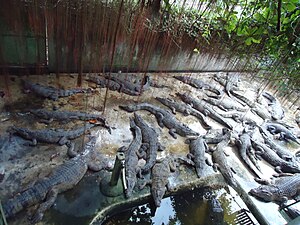Crocodile farming in the Philippines

Crocodile farming in the Philippines refers to agricultural industries involving the raising and harvesting of crocodiles for the commercial production of
In the Philippines, crocodile farmers breed and raise two species of Philippine crocodiles: the Philippine
Crocodiles help maintain the balance of Philippine ecosystems such as wetlands; crocodile farming in the Philippines is also geared towards the rescue and conservation of both C. porosus and the "endangered and endemic" C. mindorensis. Crocodile farms also contribute to tourism in the Philippines and offer public education about crocodiles.[1][2]
History
Two species of crocodiles are indigenous to the Philippines: the "saltwater crocodile". Crocodylus porosus, also known as the Indo-Pacific crocodile, thrives in the Indo-Pacific region, Australia, Brunei, India, Malaysia, Papua New Guinea, Singapore, and Thailand. The Mindoro crocodile (Crocodylus mindorensis) is unique to the Philippines that tends to prefer a freshwater habitat. The latter – is considered "critically endangered" by the International Union for Conservation of Nature (IUCN) – is found in
The first crocodile breeding farm in the Philippines was started in
In 2013 the PWRCC – under the management of the Protected Areas and Wildlife Bureau of the Department of Environment and Natural Resources (DENR) – were breeding over 600 Mindoro crocodiles and over 700 Philippine saltwater crocodiles for commercial purposes.[1]
Industry
Players
The PWRCC sells hatchlings,[8] as well as saltwater crocodile products to seven "authorized commercial operators" in the regions of Luzon (particularly in Batangas, Cavite, Rizal, and Tarlac), Visayas (such as in Negros Occidental), and Mindanao (including Cagayan de Oro and Davao del Norte).[1]
Crocodile farms have to be accredited by the government;
There are three smaller farms, including one combined ostrich/croc facility, where crocodiles reared number in the low hundreds.[4][10] Then there are two pig farm turned crocodile "tourist centers" in Davao (without Philippine government accreditation).[9]
Products
Crocodile skins are extremely valuable, priced by the centimeter, and are used in the production of luxury leather goods by firms such as luxury fashion brands like Louis Vuitton.[2] In particular, the hide of C. Porosus is the most commercially valuable of any crocodilian. It is highly prized for its regular, almost perfect pattern symmetry, and is the type used almost exclusively by Hermès; crocodile skin versions of Birkin bag and Kelly bag are made from the skin of the C. porosus.[3]
Meat is sold locally to tourists and to restaurants across the country – one kilogram of crocodile meat can fetch between 400 and 1000 Pesos ($9 and $22) in 2013. The meat supposedly has aphrodisiac properties, and can be used to cook traditional Philippine dishes. It may be found in prepared meals such as adobo, sisig, or made into hot dogs and burgers, or used in soups. Export markets include China and Russia.[8]
See also
References
- ^ a b c d e f g h "Crocodiles in the Philippines". Department of Environment and Natural Resources (DENR). Retrieved December 28, 2013.
- ^ a b c d e f Regalado, Edith (July 5, 2013). "Louis Vuitton buying Phl croc skins". The Philippine Star
- ^ a b Tetta Ortiz Matera (March 20, 2013). "Crocodile Skin 101" , The Philippine Star
- ^ a b c d e "Palawan Wildlife Rescue and Conservation Center". Philippine CHM. 2009. Retrieved December 31, 2013.
- ISBN 978-9712327506. Retrieved December 31, 2013.
- ^ "Palawan broadcaster shot dead, gunman caught". GMA News. January 24, 2011. Retrieved December 31, 2013.
- ^ "Croc farm soon up for lease". The Philippine Star, November 2, 2005
- ^ a b c d Valencia, Czeriza (July 31, 2013). "Yum yum… crocodile meat, anyone?", The Philippine Star
- ^ a b c Simmons-Ritchie, Daniel (March 11, 2012). "King crocodile", Star Week
- ^ "Philippine Ostrich & Crocodile Farm". Municipality of Opol. 8 October 2013. Retrieved 15 January 2014.
External links
- Palawan Wildlife Rescue and Conservation Center (PWRCC)
- Crocodile Farm in Puerto Princesa City, Palawan, Philippines
- If you want to visit the Palawan Wildlife Rescue and Conservation Center by video : https://www.youtube.com/watch?v=HEJvDTitOwI - A video by Arctictis Binturong Conservation (http://abconservation.org)
